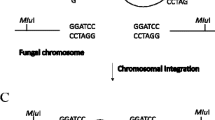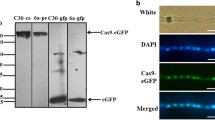Abstract
Filamentous fungi have wide applications in the field of biotechnology. The use of transcription activator-like effectors (TALEs) is a powerful genome-engineering tool, which can facilitate genome editing and transcriptional modulation, and has been used for genetic modification in a variety of organisms. However, a transcription activator-like effectors nuclease (TALEN) approach has not been used in filamentous fungi so far. Here, we aimed to establish the shortest TALEN and TALE-transcription factor (TALE-TF) proteins for use in gene modification and transcription in the filamentous fungus Trichoderma reesei. The alternative tandem repeat unit of the TALEs was first established by the ligation of two isocaudamers: XbaI and SpeI, instead of the natural unit. In addition, we adopted T. reesei expression assays to monitor the activities of the TALENs and TALE-TF in vivo in T. reesei. Our results showed that TALEs are a powerful genome-manipulating tool for use in T. reesei and other filamentous fungal species and that their use might facilitate studies on functional genomics and strain improvement in these filamentous fungi.





Similar content being viewed by others
References
Briggs AW, Rios X, Chari R et al (2012) Iterative capped assembly: rapid and scalable synthesis of repeat-module DNA such as TAL effectors from individual monomers. Nucleic Acids Res 40(40):283–288
Carlson DF, Tan W, Lillico SG et al (2012) Efficient TALEN-mediated gene knockout in livestock. Proc Natl Acad Sci USA 109(43):17382–17387
Fu Y, Foden JA, Khayter C et al (2013) High frequency off-target mutagenesis induced by CRISPR-Cas nucleases in human cells. Nat Biotechnol 31(9):822–826
Gerlach JQ, Sharma S, Leister KJ et al (2012) A tight-knit group: protein glycosylation, endoplasmic reticulum stress and the unfolded protein response. In: Agostinis P, Samali A (eds) Endoplasmic reticulum stress in health and disease, pp 23–39
Huang P, Xiao A, Zhou M, Zhu Z, Lin S, Zhang B (2011) Heritable gene targeting in zebrafish using customized TALENs. Nat Biotech 29:699–700
Hwang WY, Peterson RT, Yeh JR (2014) Methods for targeted mutagenesis in zebrafish using TALENs. Methods 69(1):76–84
Jiang D, Zhu W, Wang Y, Sun C, Zhang KQ, Yang J (2013) Molecular tools for functional genomics in filamentous fungi: recent advances and new strategies. Biotechnol Adv 31:1562–1574
Liu J, Li C, Yu Z et al (2012) Efficient and specific modifications of the Drosophila genome by means of an easy TALEN strategy. J Genet Genom 39(5):209–215
Liu R, Chen L, Jiang Y et al (2015) Efficient genome editing in filamentous fungus Trichoderma reesei using the CRISPR/Cas9 system. Cell Discov 1:15007
Mahfouz MM, Zhu JK (2011) De novo-engineered transcription activator-like effector (TALE) hybrid nuclease with novel DNA binding specificity creates double-strand breaks. Proc Natl Acad Sci 108(6):2623–2628
Mandels M, Andreotti RE (1978) Problems and challenges in the cellulose to cellulase fermentation. Process Biochem 13(5):6–10
Moscou MJ, Bogdanove AJ (2009) A simple cipher governs DNA recognition by TAL effectors. Science 326(5959):1501
Peterson R, Nevalainen H (2012) Trichoderma reesei RUT-C30-30 years of strain improvement. Microbiology 158:58–68
Reyon D, Khayter C, Regan MR et al (2012) Engineering designer transcription activator-like effector nucleases (TALENs) by REAL or REAL-Fast assembly. Chapter 12(Unit12):15
Sanjana NE, Cong L, Zhou Y et al (2012) A transcription activator-like effector toolbox for genome engineering. Nat Protoc 7(1):171–192
Suominen PL, Mäntylä AL, Karhunen T et al (1993) High frequency one-step gene replacement in Trichoderma reesei. II. Effects of deletions of individual cellulase genes. Mol Genet Genom 241(5):523–530
Taleei R, Nikjoo H (2013) The non-homologous end-joining (NHEJ) pathway for the repair of DNA double-strand breaks: I. A Mathematical Model. Radiat Res 179(5):530–539
Wang S, Wen F, Tessneer KL et al (2016) TALEN-mediated enhancer knockout influences TNFAIP3 gene expression and mimics a molecular phenotype associated with systemic lupus erythematosus. Genes Immun 17(3):165
Wang W, Meng F, Liu P et al (2014) Construction of a promoter collection for genes co-expression in filamentous fungus Trichoderma reesei. J Ind Microbiol Biotechnol 41(11):1709–1718
Wang W, Shi XY, Wei DZ (2014) Light-mediated control of gene expression in filamentous fungus Trichoderma reesei. J Microbiol Methods 103:37–39
Wood AJ, Lo TW, Zeitler B et al (2011) Targeted genome editing across species using ZFNs and TALENs. Science 333(6040):307
Zhang F, Cong L, Lodato S et al (2011) Efficient construction of sequence-specific TAL effectors for modulating mammalian transcription. Nat Biotechnol 29(2):149–153
Zhang L, Zhao X, Zhang G et al (2016) Light-inducible genetic engineering and control of non-homologous end-joining in industrial eukaryotic microorganisms: LML 3.0 and OFN 1.0. Sci Rep 6:20761
Zhong Y, Wang X, Yu H et al (2012) Application of T-DNA insertional mutagenesis for improving cellulase production in the filamentous fungus Trichoderma reesei. Biores Technol 110(4):572–577
Acknowledgements
This research was supported by the National Natural Science Foundation of China (No. C010302-31500066), and the Fundamental Research Funds for the Central Universities (No. 222201714053).
Author information
Authors and Affiliations
Contributions
Wei Wang initiated, designed, and coordinated the study and reviewed the manuscript. Pei Liu planned and carried out experiments and measurements, and interpreted experimental data. Dongzhi Wei and Wei Wang supported the research funding. All authors have read and approved the final manuscript.
Corresponding author
Ethics declarations
Conflict of interest
The authors declare no conflict of interest.
Electronic supplementary material
Below is the link to the electronic supplementary material.
Rights and permissions
About this article
Cite this article
Liu, P., Wang, W. & Wei, D. Use of transcription activator-like effector for efficient gene modification and transcription in the filamentous fungus Trichoderma reesei . J Ind Microbiol Biotechnol 44, 1367–1373 (2017). https://doi.org/10.1007/s10295-017-1963-7
Received:
Accepted:
Published:
Issue Date:
DOI: https://doi.org/10.1007/s10295-017-1963-7




